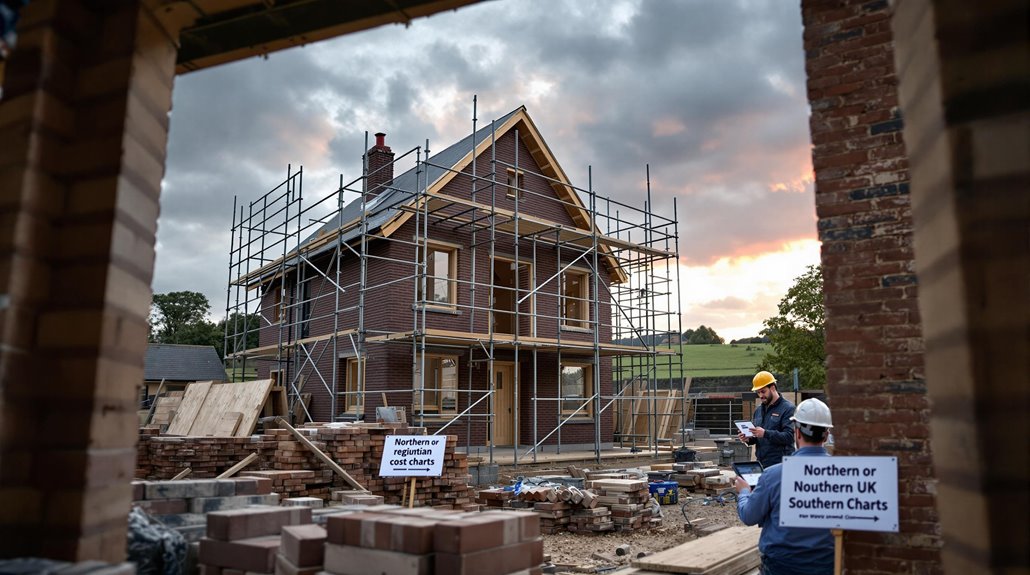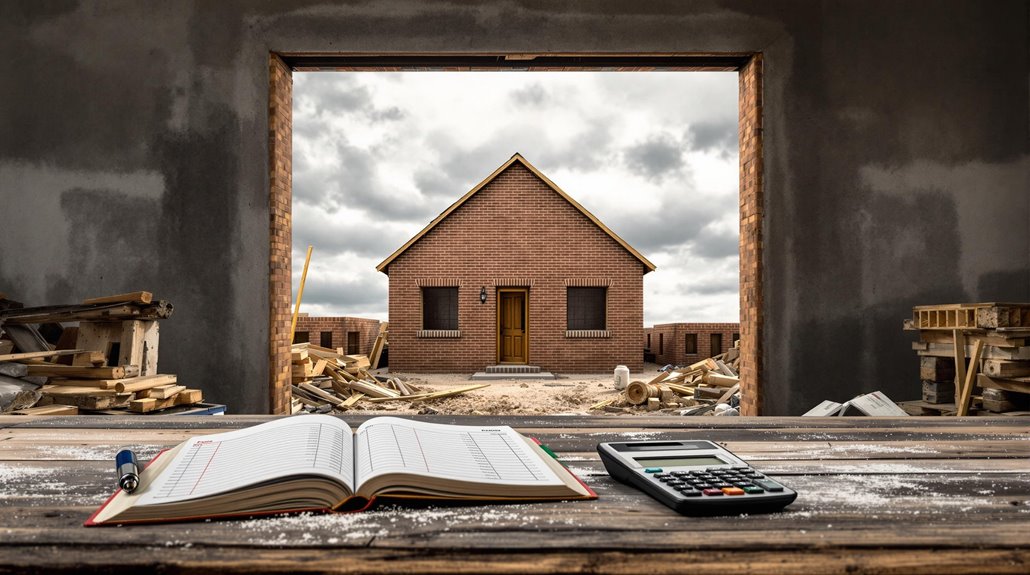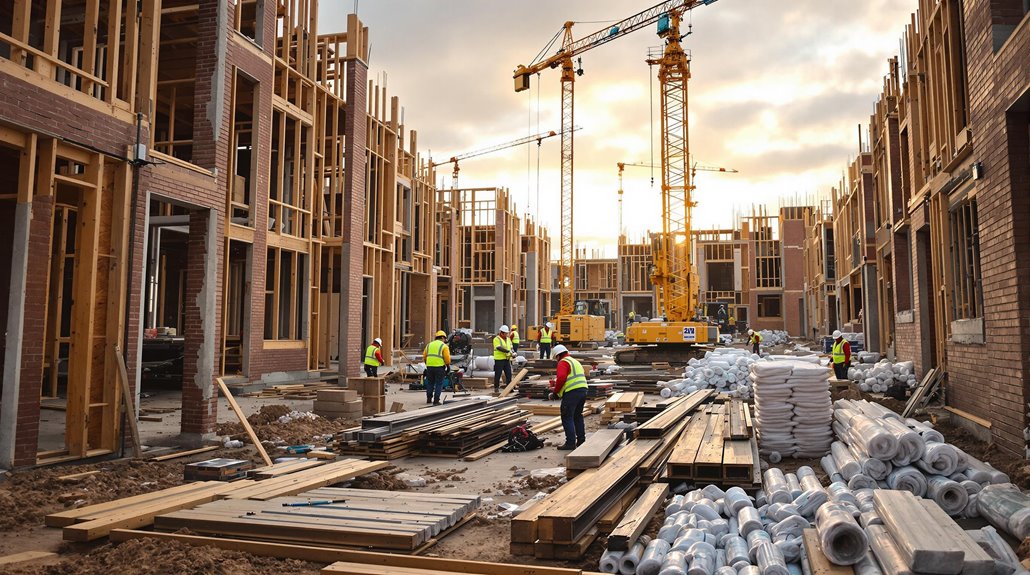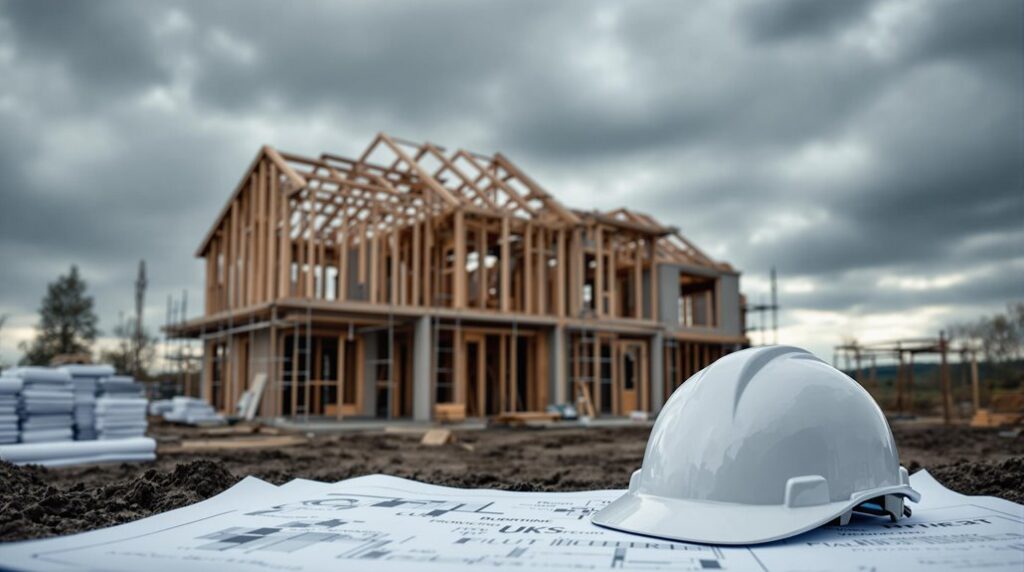I’ve been analyzing UK construction costs for years, and I’ll tell you straight—building a house for £100K isn’t impossible, but it’s far trickier than most people realize. The headline figure sounds achievable until you factor in regional variations, hidden expenses, and the current state of material prices. What shocked me most wasn’t the base construction costs themselves, but rather the additional expenses that consistently blindside even experienced builders.
Key Takeaways
- A £100K budget can build approximately 67 square meters of basic house, excluding land costs which represent 30-40% of total expenses.
- Real examples exist: Marcus and Sholto, plus Jason and Rika successfully completed self-builds for around £100,000 each.
- Prefab homes offer better value at £14,000-£100,000 compared to traditional builds costing £180,000-£440,000+ for complete houses.
- Regional costs vary dramatically: London averages £3,144-£3,907 per square meter versus North England’s more affordable £2,815-£3,169 range.
- Hidden expenses include architect fees, planning permissions, utility connections, and regulatory requirements adding 15% for professional fees alone.
Current UK Building Costs Breakdown by Region

Building costs across the UK vary greatly by region, with London commanding the highest prices at £3,144–£3,907 per square metre compared to the North’s more affordable £2,815–£3,169 range. I’ve analyzed current data showing a 3-bed house costs £331,321 in London versus £288,659 in the North—that’s a £42,662 difference.
The South East follows closely behind London at £328,900 for the same property, while the Midlands sits in the middle at £296,057. Scotland’s costs align with the Midlands at £298,570. London’s 12% premium over other regions stems from higher labour rates and material costs. Additionally, the potential for increased living space through options like basement extensions can further impact overall project costs.
These regional variations mean your £100K budget stretches differently depending on location. Northern England offers the best value, while southern regions demand considerably higher investment for identical specifications. The volatile housing market continues to create additional uncertainty for potential self-builders planning their projects.
What £100K Actually Gets You in Construction
Understanding these regional cost differences helps set realistic expectations, but let’s examine exactly what your £100,000 budget delivers in concrete terms.
At minimum construction costs of £1,500 per square meter, you’re looking at roughly 67 square meters—that’s a compact two-bedroom house or spacious one-bedroom. This assumes the most basic materials and finishes, falling below even standard build quality. A house extension can also significantly increase your living space, providing more room for your needs.
Your budget covers only the shell and basic internals. You’ll get essential structural elements, basic plumbing, and electrical work, but don’t expect premium fixtures or high-end finishes. Remember that seasonal changes can raise material prices by 3-5% during summer months, potentially stretching your budget even thinner.
Crucially, this excludes land acquisition, which typically represents 30-40% of total project costs. You’ll also need separate budgets for architect fees, planning permissions, and utility connections—costs that can quickly consume another £20,000-30,000.
Hidden Expenses That Double Your Budget

While most builders focus on obvious construction costs, the hidden expenses lurking beneath your £100K budget can easily push total expenditure beyond £200,000.
I’ve seen countless projects derail when builders overlook location-specific costs. London’s construction expenses hit £4,133 per square meter for high-rise builds—that’s triple the national average. Manchester isn’t much better, ranking second nationally for residential costs. Additionally, concrete shortages are causing significant delays and skyrocketing costs, further complicating the financial landscape for home builders.
You’ll also face unpredictable temporary accommodation expenses if delays occur. Nightly rates range from £40 to £200, with volatile pricing creating budget chaos. Extended delays can match rental costs entirely. Local authorities are grappling with TA costs that reached £2.42 billion in 2023-24, demonstrating how these expenses spiral beyond initial estimates.
Health-related building defects add another layer. Poor construction costs the NHS £1.4 billion annually, with 11% of England’s housing containing Category 1 hazards requiring expensive remediation. These aren’t optional fixes—they’re legal requirements that’ll drain your contingency fund fast.
Real Project Examples and Cost Comparisons
Three real-world case studies prove £100K house builds aren’t just theoretical—they’re achievable with smart planning and material choices.
Marcus and Sholto completed their self-build for approximately £100,000, while Jason and Rika delivered their coastal home within the same budget. These documented builds from “The House That £100K Built” demonstrate what’s possible when you prioritize function over luxury. Understanding the importance of comparing agents can also help save costs in the building process.
The cost comparison is striking: prefab homes range from £14,000 to £100,000, while traditional builds cost £180,000 to £440,000+. That 1050 sq ft prefab I mentioned earlier? It includes everything you need—living room, kitchen, bedroom, bathroom, and outdoor deck—for under £100K. The controlled construction environment in prefab manufacturing eliminates weather delays and reduces waste significantly.
Factory-built homes deliver in weeks versus months, though you’ll sacrifice some customization for massive savings.
Major Factors Driving Up Construction Prices

Construction costs spiral beyond £100K faster than most self-builders expect, and five key factors consistently drive these overruns.
Material costs hit hardest. Steel, timber, and eco-friendly options fluctuate wildly due to supply chain pressures. Cross-laminated timber alone adds 10% to your total budget, while premium materials can push costs considerably higher. Understanding the importance of permitted development rights can help homeowners make more cost-effective decisions when choosing materials.
Labour shortages create bidding wars. Post-Brexit challenges and an ageing workforce mean you’ll pay premium rates for skilled trades. Regional variations affect pricing substantially.
Site conditions surprise everyone. Poor access, challenging ground conditions, and utility connections add unexpected expenses. Specialist foundations can double your groundwork budget.
Design complexity compounds costs. Complex layouts increase material and labour needs by 10-20%.
Regulatory requirements add fixed costs. Planning applications, building regulations compliance, and environmental standards create unavoidable professional fees that chip away at your £100K target. Professional fees typically require an additional 15% of your total construction budget for architects, engineers, and other specialists.
Proven Strategies to Slash Building Costs
Cost overruns don’t have to derail your £100K house project if you apply strategic cost-cutting methods from day one. I’ll share the proven techniques that can make your budget work.
Start with simple architectural designs and modular construction techniques—you’ll cut costs by up to 20%. Use Building Information Modelling (BIM) to catch design clashes early, reducing rework by 15%. I recommend e-tendering platforms for procurement, which deliver up to 12% savings through competitive bidding.
Choose locally sourced materials and negotiate bulk discounts with suppliers. Installing energy-efficient systems now—they’ll slash your operational costs later. Additionally, consider the common cost ranges associated with various types of extensions, as this can inform your overall budget. Conduct thorough site evaluations upfront to avoid costly surprises. Appoint a quantity surveyor early in the process to ensure accurate cost estimations and maintain accountability throughout your project.
Most importantly, maintain rigorous on-site supervision and use digital tools for real-time budget monitoring. These strategies transform ambitious budgets into achievable realities.
Conclusion
I’ve shown you that building for £100K is possible, but you’ll need laser focus on cost control. You can’t afford surprises—budget an extra 20% for hidden expenses and stick to basic finishes. Your biggest wins come from doing groundwork yourself, buying materials directly, and avoiding change orders. It’s achievable if you’re realistic about specifications and prepared to put in significant sweat equity. Don’t underestimate the planning phase.
References
- https://urbanistarchitecture.co.uk/cost-to-build-a-house-uk/
- https://www.checkatrade.com/blog/cost-guides/building-cost-per-sq-m/
- https://buonconstruction.com/average-building-costs-per-sq-m-in-uk/
- https://amazingarchitecture.com/articles/the-latest-guide-to-cost-of-building-a-house-in-the-uk-in-2025
- https://devisarchitecture.com/new-build/how-much-does-it-cost-to-build-a-new-house-in-2025-uk/
- https://buildpartner.com/how-much-does-it-cost-to-build-a-house-in-2025-a-uk-guide/
- https://www.gov.uk/government/news/uk-house-price-index-for-april-2025
- https://www.designsindetail.com/articles/how-much-does-it-cost-to-build-a-house-in-the-uk-in-2025
- https://buildpartner.com/average-building-costs-per-sq-m-for-2025-a-uk-guide/
- https://globequestconsulting.com/how-to-estimate-building-cost-in-the-uk-guide/

